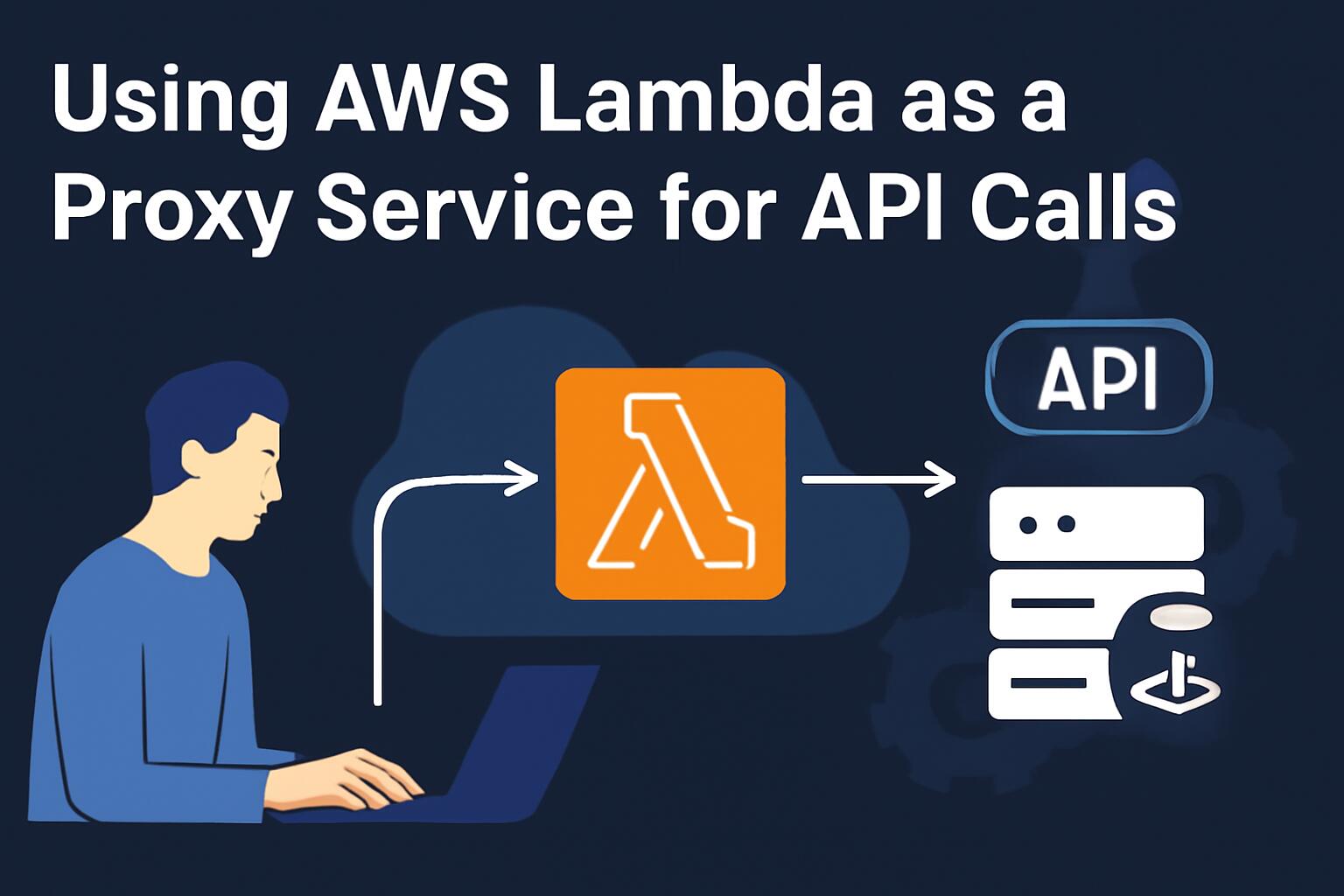AWS Lambda is a serverless compute service that lets you run code in response to events. It’s a powerful tool for building scalable applications without the need to manage servers. One of the common use cases for AWS Lambda is creating proxy services for API calls. This article will explore how you can use AWS Lambda as a proxy service to forward API requests to another service, process the responses, and return them to the client.
Setting Up AWS Lambda for Proxy Services
To use AWS Lambda as a proxy service, you need to start by creating a Lambda function in the AWS Management Console. The Lambda function will handle incoming API requests, pass them to an external API or service, and return the response. Here’s how you can set up a basic proxy Lambda function:
1. **Create a Lambda Function**
In the AWS Management Console, go to AWS Lambda and create a new function. Choose “Author from Scratch” and give it a name like APIGatewayProxyFunction. Select a runtime, such as Node.js, Python, or Go.
2. **Define API Gateway as an Event Source**
Next, configure the AWS API Gateway to invoke your Lambda function. API Gateway will handle incoming HTTP requests and pass them to your Lambda function. You can define an HTTP endpoint using the API Gateway console or define your API using Swagger/OpenAPI.
3. **Set Permissions**
You need to set appropriate permissions for your Lambda function to allow it to be triggered by API Gateway and make HTTP requests to the external API. Use an IAM role with the necessary permissions to allow API Gateway to invoke Lambda functions.
Building the Lambda Proxy Code
In this section, we’ll write the Lambda function code that acts as a proxy. The function will receive HTTP requests, forward them to an external API, and return the response back to the client. Here’s an example of how you can implement the proxy using Node.js.
javascript
const https = require(‘https’);
exports.handler = async (event) => {
const apiUrl = ‘https://example.com/api’; // The external API endpoint
const options = {
hostname: ‘example.com’,
path: ‘/api’,
method: ‘GET’,
headers: {
‘Content-Type’: ‘application/json’,
},
};
return new Promise((resolve, reject) => {
const req = https.request(options, (res) => {
let data = ”;
res.on(‘data’, (chunk) => {
data += chunk;
});
res.on(‘end’, () => {
resolve({
statusCode: res.statusCode,
body: data,
});
});
});
req.on(‘error’, (e) => {
reject({
statusCode: 500,
body: JSON.stringify({ message: e.message }),
});
});
req.end();
});
};
This function takes in the incoming event from API Gateway, which contains information about the HTTP request, and forwards it to an external API using the https module. After receiving the response from the external API, the Lambda function returns it to the client.
Processing Incoming API Requests
When a request is made to the API Gateway endpoint, the event object passed to your Lambda function will contain details about the HTTP method, query parameters, headers, and body. These details can be used to tailor your proxy service based on the incoming request.
For example, if you want to handle POST requests with a JSON body, you could parse the event.body property in your Lambda function like this:
javascript
const eventBody = JSON.parse(event.body);
You can then use this parsed data to modify the request before sending it to the external API.
Handling Authentication
When using AWS Lambda as a proxy for an external API, you often need to handle authentication. Many APIs require API keys or OAuth tokens for secure access. You can pass these credentials in the request headers or use AWS Secrets Manager to securely store and retrieve credentials.
Here’s an example of how you can add an API key to the request headers:
javascript
const options = {
hostname: ‘example.com’,
path: ‘/api’,
method: ‘GET’,
headers: {
‘Authorization’: ‘Bearer YOUR_API_KEY’,
‘Content-Type’: ‘application/json’,
},
};
In a real-world application, you would likely store sensitive credentials in AWS Secrets Manager and retrieve them in your Lambda function like this:
javascript
const AWS = require(‘aws-sdk’);
const secretsManager = new AWS.SecretsManager();
async function getSecretValue(secretName) {
const data = await secretsManager.getSecretValue({ SecretId: secretName }).promise();
return JSON.parse(data.SecretString);
}
Optimizing API Call Latency
When using Lambda as a proxy, latency is a key consideration, especially when dealing with external APIs. To minimize the impact of latency, consider the following optimizations:
API Caching
You can cache frequent API responses at the API Gateway level to reduce the number of calls made to the external API. This can significantly improve the response time for repeat requests.
Concurrency
AWS Lambda can scale automatically to handle multiple concurrent requests. However, if you have a high throughput, you may want to adjust the function’s concurrency limits to ensure it can handle large volumes of traffic.
Cold Starts
Lambda functions experience “cold starts” when they are invoked after a period of inactivity. This can add latency to the first request. You can reduce cold starts by optimizing the size of your deployment package and using provisioned concurrency.
Logging and Monitoring Lambda Proxies
It’s essential to monitor and debug your Lambda function to ensure it operates as expected. AWS CloudWatch is a powerful tool for logging Lambda invocations and monitoring their performance.
In your Lambda function, you can add logging statements like this:
javascript
console.log(‘Event:’, JSON.stringify(event));
console.log(‘Response:’, JSON.stringify(response));
Additionally, AWS X-Ray can be used to trace requests and visualize the performance of your Lambda function.
javascript
const AWSXRay = require(‘aws-xray-sdk-core’);
AWSXRay.captureHTTPsGlobal(require(‘https’));
By using these tools, you can identify bottlenecks and ensure the reliability of your API proxy service.
Conclusion
Using AWS Lambda as a proxy service for API calls offers a scalable and cost-effective solution for forwarding and processing HTTP requests. With proper configuration, authentication handling, and optimizations, you can build a reliable and efficient API proxy that seamlessly integrates with external services.
We earn commissions using affiliate links.








![Best VPN for VoIP [year]: Secure and Reliable Voice Calls Best VPN for VoIP](https://www.privateproxyguide.com/wp-content/uploads/2022/01/Best-VPN-for-VoIP-150x150.jpg)
![10 Best VPN for Skype Calls [year] Unblock Skype Anyhwere Best VPN for Skype Calls](https://www.privateproxyguide.com/wp-content/uploads/2022/01/Best-VPN-for-Skype-150x150.jpg)
![Best VPN for Zoom Calls [year]: Secure Video Conferencing Best VPN for Zoom](https://www.privateproxyguide.com/wp-content/uploads/2022/11/Best-VPN-for-Zoom-150x150.jpg)

![Squid Proxies Review: Proxy Service for Businesses [year] Squid Proxies review](https://www.privateproxyguide.com/wp-content/uploads/2017/11/squid-proxies-150x150.jpg)
![Storm Proxies Review: Reliable Proxy Service for [year]? Storm Proxies Review 2021](https://www.privateproxyguide.com/wp-content/uploads/2018/10/01-storm-proxies-homepage-150x150.jpg)